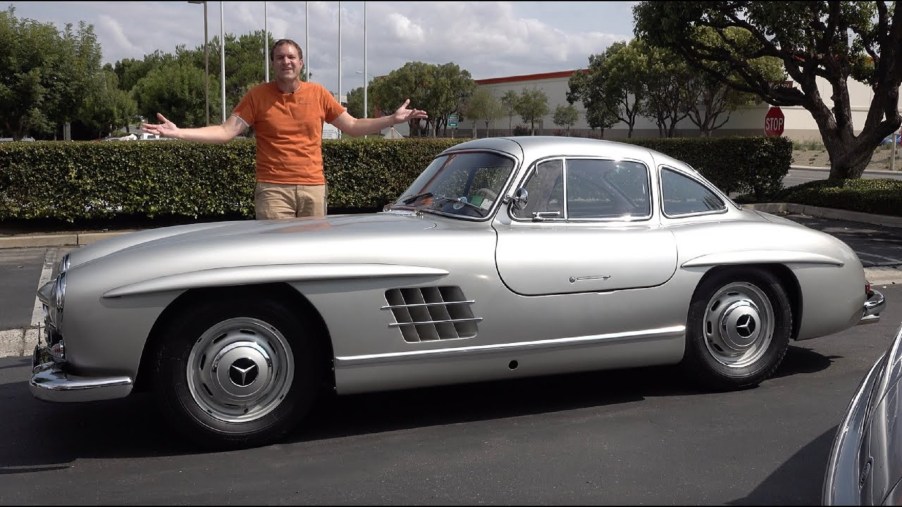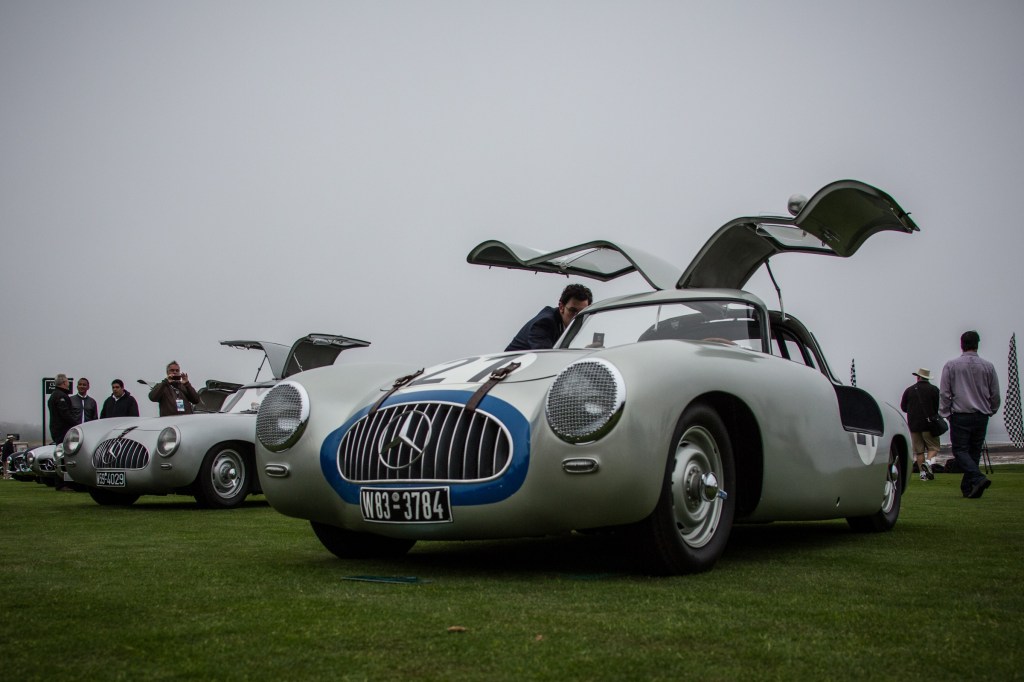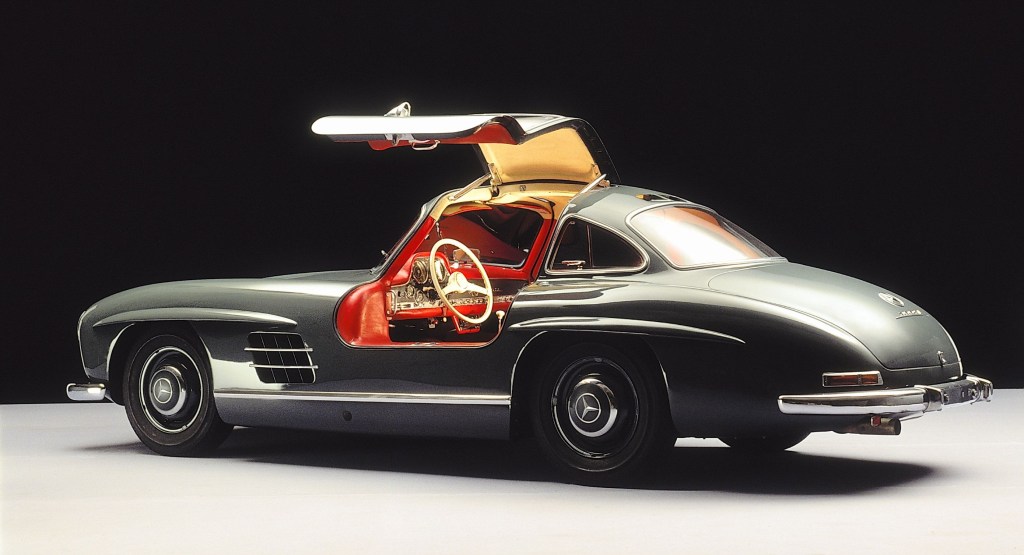
Mercedes 300SL Gullwing: The First Supercar Surprises Doug DeMuro
For many, the Lamborghini Miura, with its mid-engine layout, was the first ‘true’ supercar. But as influential as the Miura is, it wasn’t the first high-performance road car with traffic-stopping style. Back when road cars and race cars were firmly set apart, Mercedes-Benz brought them together in one super sports car: the 300SL Gullwing. This 1950s supercar still influences Mercedes and wows drivers. And the most recently awestruck driver is Doug DeMuro.
The supercar took off in 1954 when Mercedes turned a race car into the 300SL Gullwing

As iconic as the Mercedes 300SL Gullwing is today, it almost never existed. At least, not the road car.
Back in 1952, Mercedes-Benz launched its first post-WWII race car, the 300 SL, aka the W 194. The ‘SL’ stands for ‘Super Light,’ which the 300 SL was compared to most contemporary racers. This lack of weight comes from its then-innovative tubular-steel space-frame chassis, which also made the W 194 very rigid. However, this chassis demanded wide door sills, which mean conventional doors wouldn’t work. So, Mercedes fitted the 300 SL with gullwing doors.
The 300 SL race car was rather successful, earning a podium-sweep at the 1952 24 Hours of the Nürburgring and a one-two finish at Le Mans. And it got another one-two finish at the grueling 1,926-mile 1953 Carrera Panamericana in Mexico. Eager to capitalize on these victories and publicity, American Mercedes importer Maximilian ‘Maxi’ Hoffman convinced the company to make a road-going version, MotorTrend explains. And while Mercedes couldn’t put all of the racing parts into the street-going car, the space-frame chassis, “swooping shape,” and gullwing doors carried over, R&T says.
By 1950s standard, the 300SL Gullwing has supercar-level performance and tech

| Spec | 1954-1957 Mercedes 300SL ‘Gullwing’ |
| Engine | 3.0-liter fuel-injected inline-six |
| Power | 215 hp (standard) 240 hp (with optional power boost) |
| Torque | 203 lb-ft |
| Transmission | Four-speed manual |
| Curb weight | 2855 lbs |
| 0-60 mph time | 8.0 seconds (Road & Track) |
Although the 1954 Mercedes 300SL Gullwing isn’t a carbon copy of the race car, it’s an advanced car for the period. For one, while most of its body panels are steel, the hood, trunk, and door panels are aluminum. And buyers could get a full-aluminum body, too. Also, its engine is tilted by 45° to lower the hood and center of gravity.
Plus, it doesn’t have carburetors. The 300SL Gullwing is the first production car with fuel injection, which gave it extra horsepower. And depending on the axle ratio, the coupe could go over 160 mph. That made it the fastest production car in the world, Hagerty notes. Though it wasn’t until Mercedes released the 300SL Roadster that the supercar got four-wheel discs instead of drums.
The coupe’s quirks don’t stop with its doors
Speaking of the Roadster, it doesn’t have the Mercedes 300SL Gullwing coupe’s namesake doors. That’s because, as Doug DeMuro explains in the video above, Mercedes tweaked the frame enough to make conventional doors work. The new frame design also meant the Roadster has a glovebox, rather than just storage pockets. Both the coupe and the convertible have wide door sills, though.
However, while the wide sills make getting in and out tricky, the 300SL Gullwing gives drivers a helping hand. Its steering wheel folds down so you can slide your legs in more easily. Unfortunately, the buttons and switches, while stylish and made of real metal, are unlabeled, which is less helpful. Interestingly, owners see it as a point of pride, DeMuro explains, almost like flying an airplane.
Some of the Mercedes 300SL Gullwing coupe’s other quirks are period-normal, while others are racing-influenced. The high-beam switch, for instance, is foot-operated. There’s also a passenger-side horn button, presumably so a co-driver can operate it. But there’s something, well, several things missing: climate controls. Not having A/C is normal for 1950s sports cars, but the 300SL Gullwing doesn’t even have roll-down windows. That’s another limitation of the door design.
However, Mercedes gave the 300SL Gullwing more than just a dash-mounted vent. While its windows don’t roll down, they do pop out. And the quarter windows tilt out, too. Plus, while the coupe’s trunk is occupied by the spare tire, it does have an interior rear cargo area.
What amazes Doug DeMuro most about the Mercedes 300SL Gullwing is how it drives
All quirks fall to the wayside, though, once you take the Mercedes 300SL Gullwing on the road. While its mechanical fuel-injection system is more complicated than a series of carburetors, it’s “pretty bulletproof,” R&T says. But even though it’s from the 1950s, “I’m amazed at how relatively easy this car is to drive,” DeMuro says.
The clutch is heavy but linear, the shifter is accurate and “surprisingly modern,” and it feels “reasonably quick” even by today’s standards. And DeMuro is “really…amazed by well this car is put together, how nice it feels,” especially compared to some other vintage cars. He even says that some of the Lamborghinis and Ferraris of the 1970s that he’s driven didn’t feel as modern as the Gullwing. Plus, unlabeled controls aside, the Mercedes’s cabin is fairly sound, ergonomically speaking.
A common refrain amongst those who drive a Mercedes 300SL Gullwing is how simple it is to live with, R&T says. You could genuinely drive it on a racetrack, to the store, or just cruise around. And because Mercedes Classic has all the replacement parts you need, it’s less daunting to actually drive it. Little wonder Doug DeMuro calls it “one of the great icons of all time.”
Want one of these iconic classic supercars? Be prepared to pay dearly

At one point, the Mercedes 300SL Gullwings were less desirable than the Roadsters because the convertibles were easier to live with. Back in 1958, racer Sam Posey bought one for the equivalent $23.7K, R&T says. That’s sadly not the case today.
Nowadays, a good-condition 300SL Gullwing coupe is at least $1 million, Hagerty reports. And that’s without the Rudge knock-off wheels or matching luggage. Plus, not only is the coupe rarer than the roadster but there’s an even rarer coupe model. Mercedes made 29 alloy-bodied Gullwing coupes—one of those costs $4 million bare minimum, Hagerty says.
Sky-high prices led several shops to make more affordable interpretations of the Gullwing built on modern Mercedes cars. And Mercedes itself has drawn influence from the 300SL with the SLS AMG and Mercedes-AMG GT. That seems like the mark of a significant supercar.
Follow more updates from MotorBiscuit on our Facebook page.


